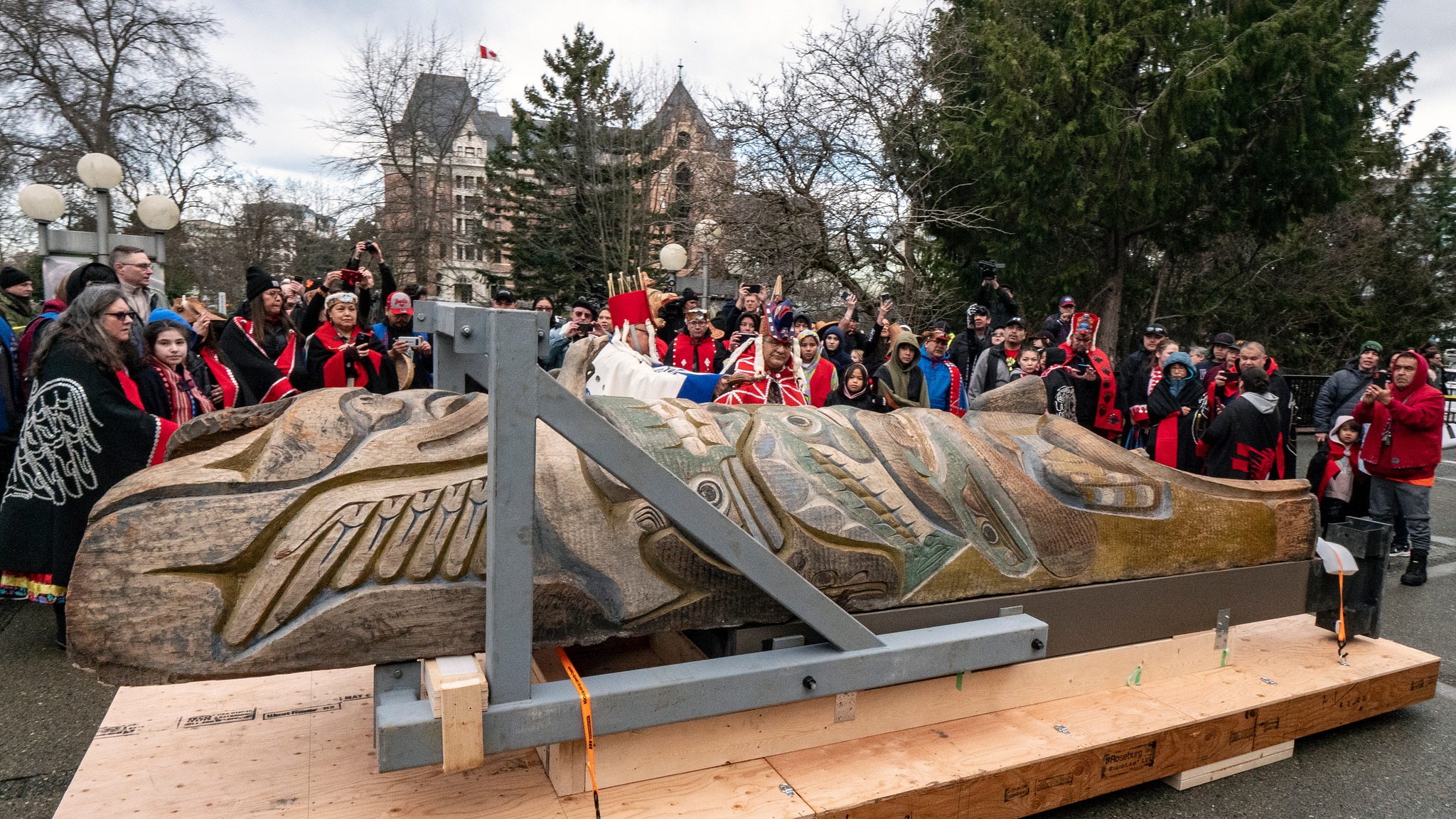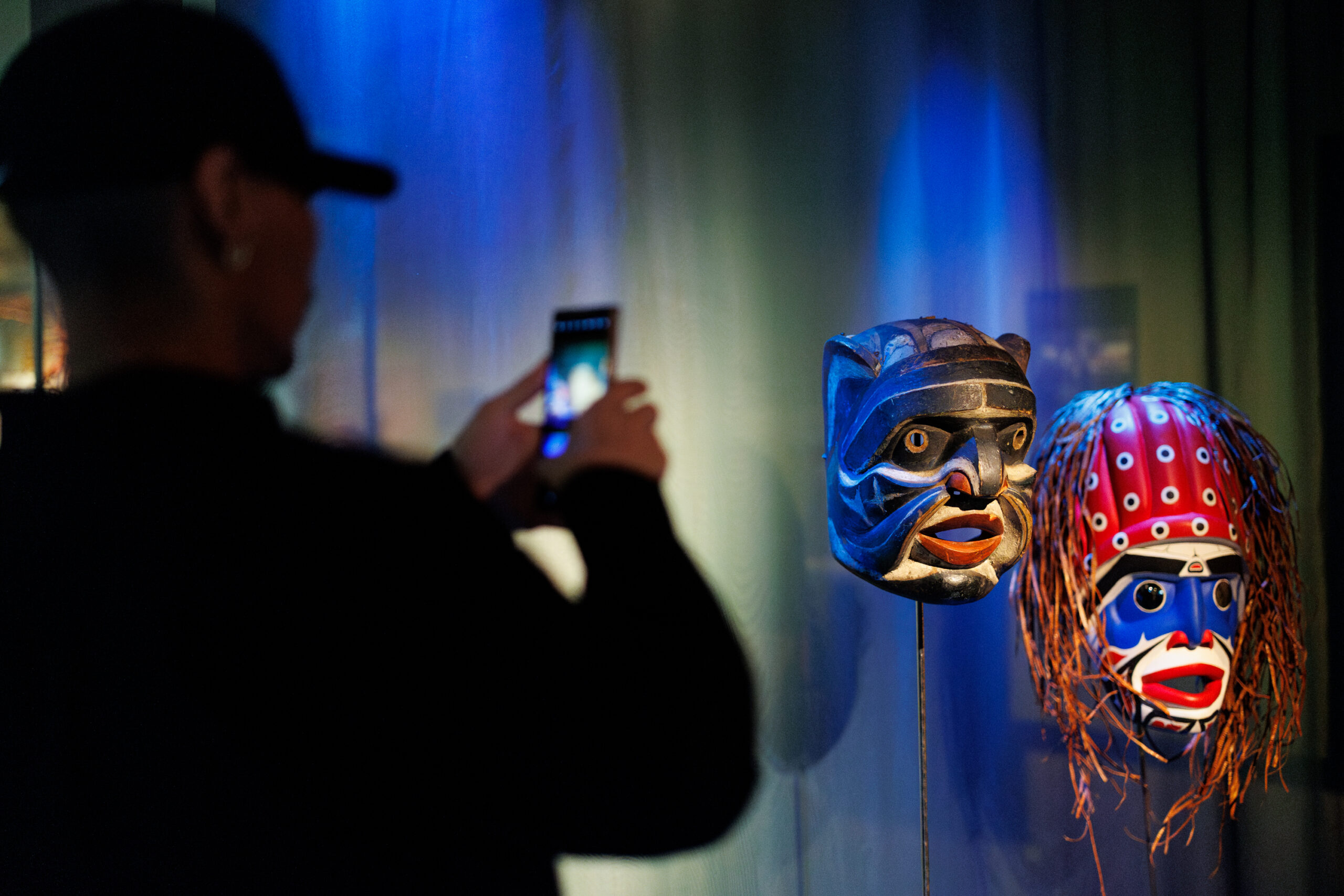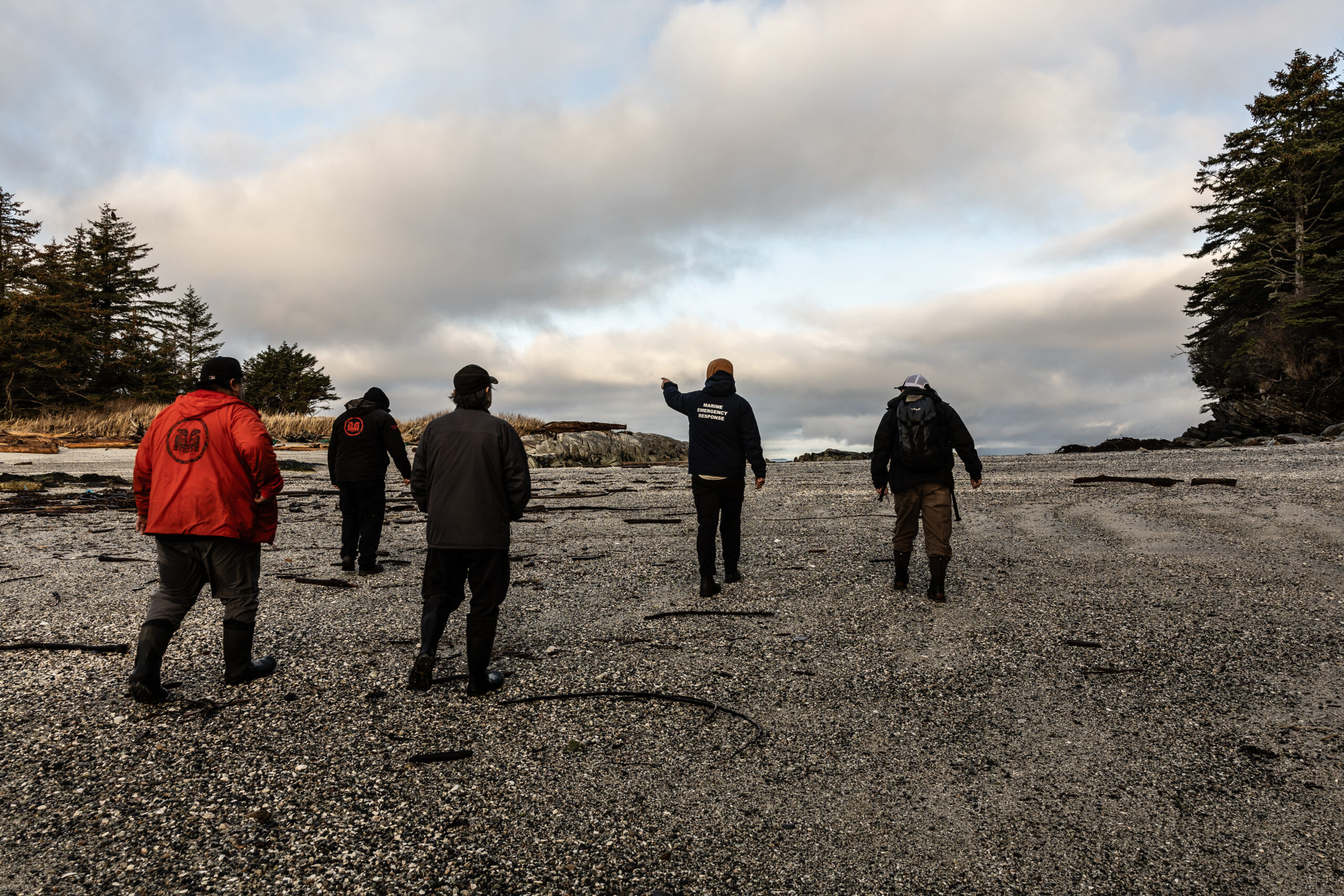After years of work, a house entrance pole was lifted out of the Royal BC Museum (RBCM), reawakened and delivered back to the Nuxalk people in their homelands, from where it was taken almost a century ago. The day had come as a result of years of hard work from the Nuxalk people committed to repatriating their sacred artifacts from museum collections. On February 13 and 14, a delegation of Nuxalk Chiefs, relatives and supporters gathered outside the RBCM to witness the event.
After blessing and reawakening the pole, the delegation moved into the Mungo Martin Bighouse, located on the land of the lək̓ʷəŋən (Lekwungen) people, to share stories, songs, and dances over two days.
“It’s a new beginning,” said Chief Snuxyaltwa (Deric Snow) who gets his name from his great grandfather, who carved the entrance house pole. “Not only for our Nuxalk Nation, but for all Nations, all over the world.”
In October 2019, four Nuxalk Hereditary Chiefs, together with many supporters from the Nation, traveled to the RBCM to request the return of their cultural artifacts. Two poles in particular were taken from their homeland in Talleomy, South Bentinck, when Nuxalk people were forced to relocate after a smallpox epidemic, according to a statement released by the Nation.
The entrance poles carved by Louie Snuxyaltwa are sacred to the Nuxalkmc people. Louie Snuxyaltwa was one of the last gifted spiritual Nuxalk carvers and many of the totem poles and canoes he created were stolen in the early 1900s and made their way to the RBCM and other international museums. Nuxalk Hereditary Chief Snuxyaltwa, who, according to the press release, has been lobbying on behalf of all Hereditary Chiefs, said his great grandfather’s spirit remains in the pole and “until this moment” has not been able to rest.
“That totem pole tells us who we are, where we come from, and why we’re here,” Chief Snuxyaltwam tells the group who filled up the Bighouse from front to back. “That pole tells us we come from Talleomy. It tells us the story of each creek, river, mountain within our territory.”
After years of community efforts and the leadership of Chief Snuxyaltwa and his family, the RBCM agreed to release one totem pole back to the Nation. Although this is a historical step in the right direction, the Nuxalk people remind the RBCM that one more totem pole and many other artifacts are overdue for repatriation, according to the release. During the proceedings, Hamisinuł Tom Child, acting as a speaker for the Bighouse, says the Kwakwaka’wakw house was built in 1953 with this exact kind of business in mind. The Potlatch Ban, one of many genocidal policies embedded in the Indian Act, was lifted in 1951, he says, and the intention of the house was to continue to breathe life into the traditions so many potlatching people had worked hard to keep alive.
“This Bighouse was opened as a symbol of the return of our ways. Its intent was to be a place for the ongoing ceremonies and potlatch traditions of our people and the gathering today is exactly the type of occasion that this house was intended for,” Hamisinuł said.


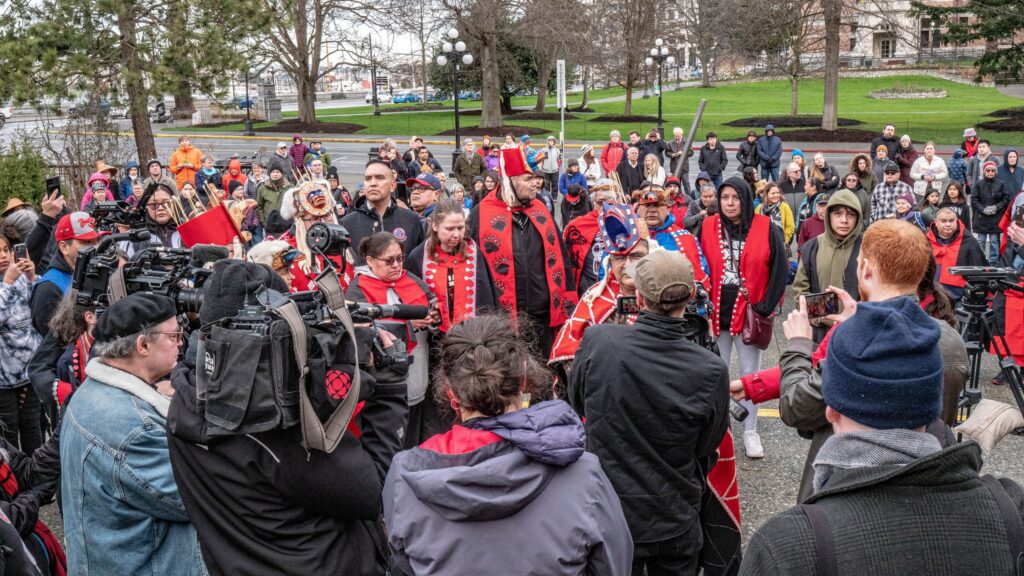
‘Bring them all home’
After representatives from the host Songhees and Esquimalt Nations shared welcoming words, speaker Bill Tallio read a letter written by RBCM Chief Executive Officer Alicia Dubois regarding the repatriation of the pole.
“The Royal Museum has finalized the process of repatriation of the pole carved by your great grandfather that was purchased in 1913 by an ethnologist in B.C. The Museum board fully understands this process has not been easy and we apologize for the challenges you’ve faced,” Tallio reads.
“We remain committed to our policy of ensuring the protection of the belongings while everyone involved determines the best step forward. We recognise that this practice is not ideal for individuals, however, we want to remain as respectful, transparent and inclusive as possible and this will depend on a mutual, trust-based relationship.This process has taught many of us at the museum valuable lessons and initiated conversations and teachings we will not forget. I hope we can move forward together in a mutually respectful relationship that holds each other up in honour of truth and reconciliation.”
The Museum provided a travel stipend for the Nuxalk delegation to travel away from home to conduct the work. Each Hereditary Chief that spoke, as well as other community members, thanked the RBCM for holding its end of a commitment to repatriate this particular pole. Minister of Indigenous Relations and Reconciliation Murray Rankin, MLA for North Coast Jennifer Rice and MLA of Saanich South Lana Popham attended the first day of gatherings and shared their reflections.
“Today is a long overdue day, a day in which we are returning, as we should have done so long ago, an important cultural property of the Nuxalk Nation,” said Minister Rankin. “It’s an honour on behalf of B.C., to share in this historic ceremony.”
Land Back
Over the course of two days, the Nuxalk Nation shared what were described as some of their most powerful stories, songs and dances, giving guests a glimpse into the animal kingdom and Nuxalk culture and governance. Chiefs, family members and relatives from other Nations took to the mic to share their reflections on the historic moment — the result of a lot of hard working people behind the scenes. Chief Snuxyaltwa said more needs to be done in the spirit of making things right. People are living in impoverished conditions on reservation systems, he said, due to the legacy left behind from residential schools and other oppressive colonial laws and policies. While there has been good work focused on healing and reclamation, repatriation needs to incorporate the land, he said, for Nuxalk people to have a place to return to as well.
“If we’re going to talk about true repatriation, I think the government has to repatriate land back to us,” said Chief Snuxyaltwa. “I want my children to be able to go back to their homeland one day. I want my grandchildren to go back to their homeland, just like this totem pole is going back today. They’re waiting for us.”
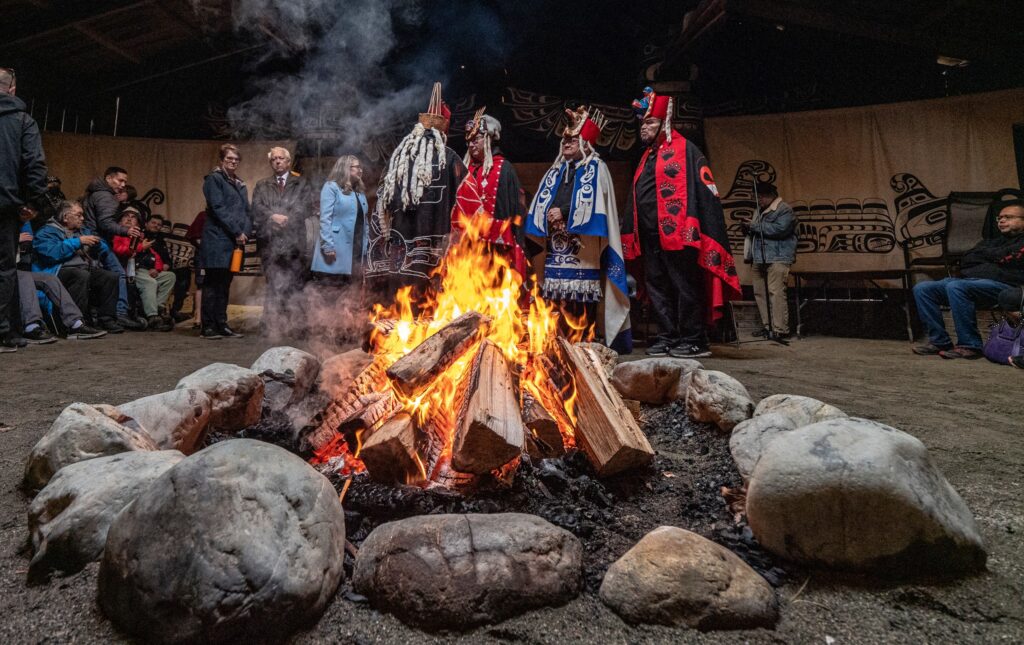
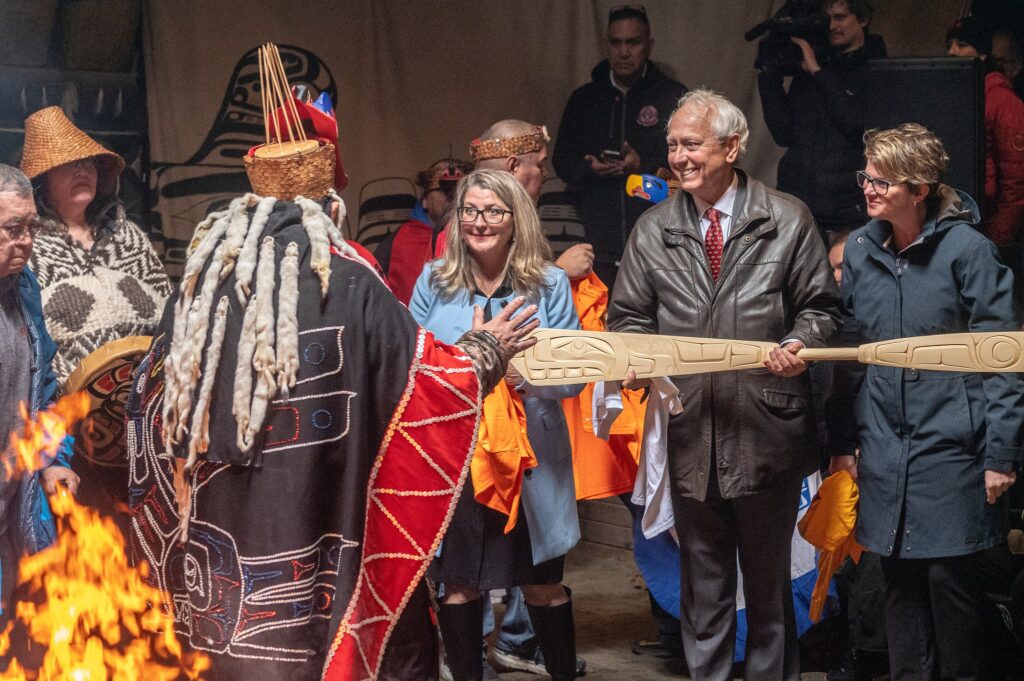
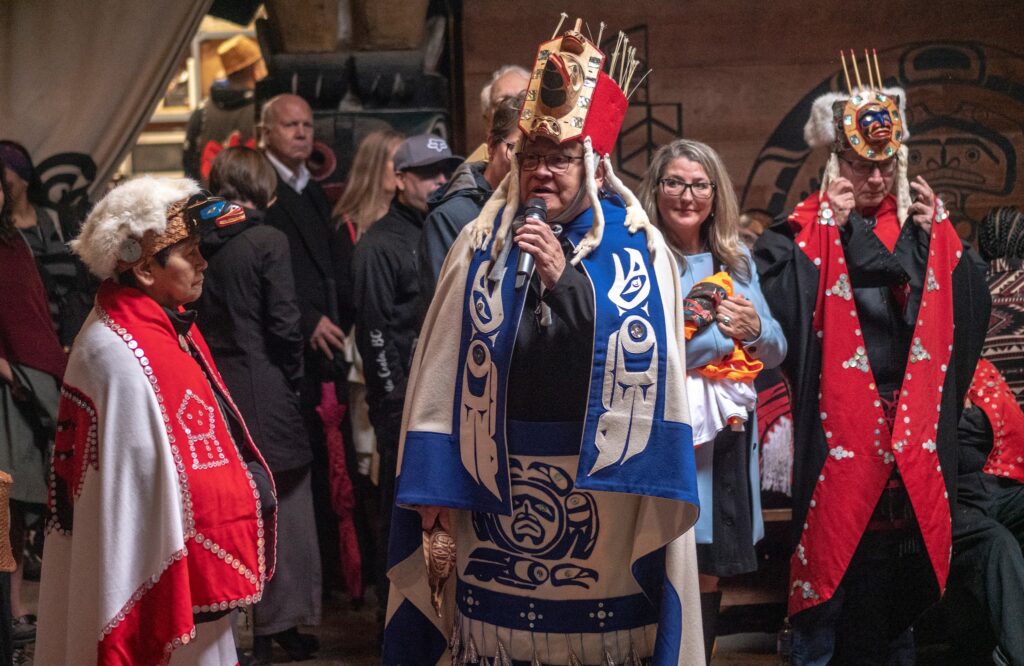
Chief Anuspuxals Jeffrey Snow shared the meaning of his Nuxalk name, “when the sun shines through the cracks of the walls of the smokehouse and the sunbeams pass through eagle down.”
“You’re standing in a place where my name is very significant,” Chief Anuspuxals shared. “There is a lot of good work being done. Many artifacts have been brought back to their communities, and this is another one, and on it goes. We need that mutual respect for one another… to help our young people realize the strength of our community and our artistry. That pole is telling our story and now that the story has been freed, we can carry on to tell more stories.”
Nuxalk community member, hip hop emcee, artist and advocate Jerilynn Snuxyaltwa Webster, JB the First Lady reminded the house that the repatriation work being done resulted from the strength of Indigenous people.
“As Indigenous people, we are still here. They built this museum to document genocide, because they thought us as Indigenous people wouldn’t be here. And guess what? We’re still here,” JB said. “My heart is full. We came here about four years ago and we were very excited to get this pole back and today, we came in a cultural way. We acknowledged the land and we were welcomed in this beautiful house that was built for this type of event. To see that totem pole go over that roof and come and land and be uncovered from the plastic… that was us, that’s a new beginning. That is us as Indigenous people.”
Elected Chief Councillor of the Nuxalk Nation Sam Schooner said it was an emotional day for many and he thanked the many people who made it possible.
“We have more artifacts out there, things we want to bring home… We need to make a home for our artifacts. We want to bring them all home,” Chief Schooner said. “We have a lot of artists and carvers coming up, our school is producing them at a fantastic rate. We might not get right back to where we were, but getting this pole back is such a huge step.”
Chief Schooner said he doesn’t agree with the term ‘reconciliation,’ which technically means two parties who have done wrong making a right, but he sees the repatriation of the pole as an act of reconciliACTION.
“That’s what we need more of,” he said. “Today’s a good day and it will be a good day when we finally get it home.”
As the pole and Nuxalk convoy took the long journey back to their homelands, they stopped on the way to feast with neighbouring Nations in Williams Lake and share their stories. They were greeted by their community in a celebratory fashion and will potlatch with their people before returning to the work.
